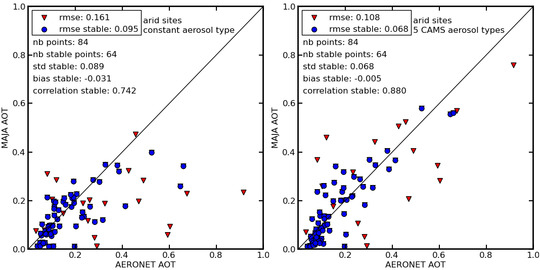Using Copernicus Atmosphere Monitoring Service Products to Constrain the Aerosol Type in the Atmospheric Correction Processor MAJA
Abstract
:1. Introduction
2. Methods and Datasets
2.1. Atmospheric Correction with MAJA
- No coarse mode, and a modal radius m for the fine mode
- Geometric standard deviation
- A refractive index with a real part of 1.53, and a spectrally variable imaginary part as shown in Table 1
2.2. Copernicus Atmosphere Monitoring Service (CAMS)
2.2.1. About CAMS and Its Products
2.2.2. Optical Properties of CAMS Aerosols
2.2.3. Aerosol Dependency on Relative Humidity
2.3. Using CAMS Products to Constrain the Aerosol Type in MAJA
2.3.1. Using Five Aerosol Types Instead of One
2.3.2. Choosing the Appropriate LUT as a Function of RH
- for each RH-dependent aerosol type (Sea Salt, Sulfate and hydrophilic Organic Matter), corresponding to the RH of the model level is interpolated. For the other types (Dust, Black Carbon and hydrophobic Organic Matter), the constant value of is used.
- the AOT of the model level is finally calculated as the sum of the optical depth of the five aerosol types:where is the AOT of the model level l, and is the AOT due to each aerosol type a at model level l. is calculated differently according to the aerosol type:
- -
- for Dust and Sea Salt, because they are described with three size bins, their mass mixing ratios (provided by CAMS) and their mass extinction coefficients are different according to the bin:where m·s is the gravity, P is the atmospheric pressure at the interface of model level l, and and are the mass extinction coefficient and mass mixing ratio, respectively, of aerosol a at model level l.
- -
- for Sulfate and Black Carbon, as they are described with only one component,
- -
- for Organic Matter, we sum its two components (hydrophilic and hydrophobic, as described in Table 2):
2.4. Dataset
3. Results and Discussion
3.1. Validation of AOT with AERONET
3.2. Validation of Surface Reflectances
3.2.1. Validation of Surface Reflectances with La Crau Measurements
3.2.2. Smoothness of Surface Reflectances
- A set of pixels, for which the stability will be evaluated, is chosen. One pixel every 1000 pixels along lines and columns is selected. Images are 10,980 × 10,980 pixels large, thus providing a set of 100 pixels.
- For each one of these 100 pixels, the mean surface reflectance for each date is computed within a 7 × 7 pixel neighbourhood for the spectral bands with a 10-m resolution (and a 4 × 4 pixel neighbourhood for the spectral bands with a 20-m resolution), to obtain 100 time series of surface reflectance. This size of the neighbourhood is chosen because the superposition precision of Sentinel-2A images is about 1 pixel, and registration errors of ± 2–3 pixels have been observed.
- For each one of these 100 pixels, the dates which are free from clouds, shadow, water, and snow are extracted, and the noise criterion described in [43] is computed:where , , and are the surface reflectances of days , , and , respectively. The difference between and the linear interpolation of and provides a characterization of the noise of the time series. This criterion assumes a linear variation of surface reflectance within a few days, and a threshold is set up allowing a maximum of 20 days between and .
- The weighted average of this criterion over the 100 pixels is computed, with the weight of each pixel being the number of dates free from clouds, shadow, water, and snow.
- Finally, the mean over the different sites presented in Section 2.4 is computed.
4. Conclusions
Acknowledgments
Author Contributions
Conflicts of Interest
References
- Fraser, R.S.; Kaufman, Y.J. The relative importance of aerosol scattering and absorption in remote sensing. IEEE Trans. Geosci. Remote Sens. 1985, 5, 625–633. [Google Scholar] [CrossRef]
- Vermote, E.; Tanré, D.; Deuzé, J.; Herman, M.; Morcette, J.J. Second Simulation of the Satellite Signal in the Solar Spectrum, 6S: An overview. IEEE Trans. Geosci. Remote Sens. 1997, 35, 675–686. [Google Scholar] [CrossRef]
- Kaufman, Y.J.; Sendra, C. Algorithm for automatic atmospheric corrections to visible and near-IR satellite imagery. Int. J. Remote Sens. 1988, 9, 1357–1381. [Google Scholar] [CrossRef]
- Liang, S.; Fang, H.; Chen, M. Atmospheric correction of Landsat ETM+ land surface imagery. I. Methods. IEEE Trans. Geosci. Remote Sens. 2001, 39, 2490–2498. [Google Scholar] [CrossRef]
- Ouaidrari, H.; Vermote, E.F. Operational atmospheric correction of Landsat TM data. Remote Sens. Environ. 1999, 70, 4–15. [Google Scholar] [CrossRef]
- Ju, J.; Roy, D.P.; Vermote, E.; Masek, J.; Kovalskyy, V. Continental-scale validation of MODIS-based and LEDAPS Landsat ETM+ atmospheric correction methods. Remote Sens. Environ. 2012, 122, 175–184. [Google Scholar] [CrossRef]
- Richter, R. A spatially adaptive fast atmospheric correction algorithm. Int. J. Remote Sens. 1996, 17, 1201–1214. [Google Scholar] [CrossRef]
- Richter, R.; Schläpfer, D.; Müller, A. An automatic atmospheric correction algorithm for visible/NIR imagery. Int. J. Remote Sens. 2006, 27, 2077–2085. [Google Scholar] [CrossRef]
- Vermote, E.; Justice, C.; Claverie, M.; Franch, B. Preliminary analysis of the performance of the Landsat 8/ OLI land surface reflectance product. Remote Sens. Environ. 2016, 185, 46–56. [Google Scholar] [CrossRef]
- Hagolle, O.; Huc, M.; Villa Pascual, D.; Dedieu, G. A multi-temporal and multi-spectral method to estimate aerosol optical thickness over land, for the atmospheric correction of FORMOSAT-2, LANDSAT, VENμS and SENTINEL-2 images. Remote Sens. 2015, 7, 2668–2691. [Google Scholar] [CrossRef]
- Rahman, H.; Dedieu, G. SMAC: A simplified method for the atmospheric correction of satellite measurements in the solar spectrum. Int. J. Remote Sens. 1994, 15, 123–143. [Google Scholar] [CrossRef]
- Hagolle, O.; Dedieu, G.; Mougenot, B.; Debaecker, V.; Duchemin, B.; Meygret, A. Correction of aerosol effects on multi-temporal images acquired with constant viewing angles: Application to Formosat-2 images. Remote Sens. Environ. 2008, 112, 1689–1701. [Google Scholar] [CrossRef] [Green Version]
- Levy, R.C.; Mattoo, S.; Munchak, L.A.; Remer, L.A.; Sayer, A.M.; Patadia, F.; Hsu, N.C. The Collection 6 MODIS aerosol products over land and ocean. Atmos. Meas. Tech. 2013, 6, 2989–3034. [Google Scholar] [CrossRef]
- Remer, L.A.; Kaufman, Y.J.; Tanré, D.; Mattoo, S.; Chu, D.A.; Martins, J.V.; Li, R.R.; Ichoku, C.; Levy, R.C.; Kleidman, R.G. The MODIS aerosol algorithm, products, and validation. J. Atmos. Sci. 2005, 62, 947–973. [Google Scholar] [CrossRef]
- Lenoble, J.; Herman, M.; Deuzé, J.L.; Lafrance, B.; Santer, R.; Tanré, D. A successive order of scattering code for solving the vector equation of transfer in the Earth’s atmosphere with aerosols. J. Quant. Spectrosc. Radiat. Transf. 2007, 107, 479–507. [Google Scholar] [CrossRef]
- Dubovik, O.; Holben, B.; Eck, T.F.; Smirnov, A.; Kaufman, Y.J.; King, M.D.; Tanré, D.; Slutsker, I. Variability of absorption and optical properties of key aerosol types observed in worldwide locations. J. Atmos. Sci. 2002, 59, 590–608. [Google Scholar] [CrossRef]
- Colarco, P.; da Silva, A.; Chin, M.; Diehl, T. Online simulations of global aerosol distributions in the NASA GEOS-4 model and comparisons to satellite and ground-based aerosol optical depth. J. Geophys. Res. 2010, 115. [Google Scholar] [CrossRef]
- Lu, S.; Huang, H.-C.; Hou, Y.-T.; Tang, Y.; McQueen, J.; da Silva, A.; Chin, M.; Joseph, E.; Stockwell, W. Development of NCEP Global Aerosol Forecasting System: An Overview and Its application for improving weather and air quality forecasts. In NATO Science for Peace and Security Series: Air Pollution Modelling and Its Application XX; Steyn, D.G., Rao, S.T., Eds.; Springer Publications: Dordrecht, The Netherlands, 2010. [Google Scholar]
- Chin, M.; Rood, R.B.; Lin, S.-J.; Müller, J.-F.; Thompson, A.M. Atmospheric sulfur cycle simulated in the global model GOCART: Model description and global properties. J. Geophys. Res. 2000, 105, 24671–24687. [Google Scholar] [CrossRef]
- Yu, P.; Toon, O.B.; Bardeen, C.G.; Mills, M.J.; Fan, T.; English, J.M.; Neely, R.R. Evaluations of tropospheric aerosol properties simulated by the community earth system model with a sectional aerosol microphysics scheme. J. Adv. Model. Earth Syst. 2015, 7, 865–914. [Google Scholar] [CrossRef] [PubMed] [Green Version]
- Rubin, J.I.; Reid, J.S.; Hansen, J.A.; Anderson, J.L.; Collins, N.; Hoar, T.J.; Hogan, T.; Lynch, P.; McLay, J.; Reynolds, C.A.; et al. Development of the Ensemble Navy Aerosol Analysis Prediction System (ENAAPS) and its application of the Data Assimilation Research Testbed (DART) in support of aerosol forecasting. Atmos. Chem. Phys. 2016, 16, 3927–3951. [Google Scholar] [CrossRef]
- Toon, O.B.; Turco, R.P.; Westphal, D.; Malone, R.; Liu, M.S. A Multidimensional Model for Aerosols: Description of Computational Analogs. J. Atmos. Sci. 1988, 45, 2123–2144. [Google Scholar] [CrossRef]
- Christensen, J.H. The Danish eulerian hemispheric model—A three-dimensional air pollution model used for the arctic. Atmos. Environ. 1997, 31, 4169–4191. [Google Scholar] [CrossRef]
- Witek, M.L.; Flatau, P.J.; Quinn, P.K.; Westphal, D.L. Global sea-salt modeling: Results and validation against multicampaign shipboard measurements. J. Geophys. Res. 2007, 112. [Google Scholar] [CrossRef]
- Reid, J.S.; Hyer, E.J.; Prins, E.M.; Westphal, D.L.; Zhang, J.; Wang, J.; Christopher, S.A.; Curtis, C.A.; Schmidt, C.C.; Eleuterio, D.P.; et al. Global Monitoring and Forecasting of Biomass-Burning Smoke: Description of and Lessons From the Fire Locating and Modeling of Burning Emissions (FLAMBE) Program. IEEE J. Sel. Top. Appl. Earth Obs. Remote Sens. 2009, 2, 144–162. [Google Scholar] [CrossRef]
- Morcrette, J.J.; Boucher, O.; Jones, L.; Salmond, D.; Bechtold, P.; Beljaars, A.; Benedetti, A.; Bonet, A.; Kaiser, J.W.; Razinger, M.; et al. Aerosol analysis and forecast in the European center for medium-range weather forecasts integrated forecast system: forward modeling. J. Geophys. Res. 2009, 114. [Google Scholar] [CrossRef]
- Benedetti, A.; Morcrette, J.J.; Boucher, O.; Dethof, A.; Engelen, R.; Fisher, M.; Flentje, H.; Huneeus, N.; Jones, L.; Kaiser, J.; et al. Aerosol analysis and forecast in the European center for medium-range weather forecasts integrated forecast system: 2. Data assimilation. J. Geophys. Res. 2009, 114. [Google Scholar] [CrossRef]
- van der Werf, G.R.; Randerson, J.T.; Giglio, L.; Collatz, G.J.; Kasibhatla, P.S.; Arellano, A.F. Interannual variability in global biomass burning emissions from 1997 to 2004. Atmos. Chem. Phys. 2006, 6, 3423–3441. [Google Scholar] [CrossRef] [Green Version]
- Van der Werf, G.R.; Randerson, J.T.; Giglio, L.; Collatz, G.J.; Mu, M.; Kasibhatla, P.S.; Morton, D.C.; DeFries, R.S.; Jin, Y.; van Leeuwen, T.T. Global fire emissions and the contribution of deforestation, savanna, forest, agricultural, and peat fires (1997–2009). Atmos. Chem. Phys. 2010, 10, 11707–11735. [Google Scholar] [CrossRef] [Green Version]
- Bond, T.C.; Streets, D.G.; Yarber, K.F.; Nelson, S.M.; Woo, J.H.; Klimont, Z. A technology-based global inventory of black and organic carbon emissions from combustion. J. Geophys. Res. 2004, 109. [Google Scholar] [CrossRef]
- Janssens-Maenhout, G.; Dentener, F.; van Aardenne, J.; Monni, S.; Pagliari, V.; Orlandini, L.; Klimont, Z.; Kurokawa, J.I.; Akimoto, H.; Ohara, T.; et al. EDGAR-HTAP: A Harmonized Gridded Air Pollution Emission Dataset Based on National Inventories. Available online: http://edgar.jrc.ec.europa.eu/htap/EDGAR-HTAP_v1_final_jan2012.pdf (accessed on 8 November 2017).
- Eskes, H.J.; Antonakaki, T.; Basart, S.; Benedictow, A.; Blechschmidt, A.-M.; Chabrillat, S.; Christophe, Y.; Clark, H.; Cuevas, E.; Hansen, K.M.; et al. Upgrade verification note for the CAMS near-real time global atmospheric composition service, Copernicus Atmosphere Monitoring Service (CAMS) Report. Available online: http://atmosphere.copernicus.eu/sites/default/files/repository/CAMS84_2015SC1_D84.3.2_201611_esuite_v1_0.pdf (accessed on 8 November 2017).
- Drusch, M.; del Bello, U.; Carlier, S.; Colin, O.; Fernandez, V.; Gascon, F.; Hoersch, B.; Isola, C.; Laberinti, P.; Martimort, P.; et al. Sentinel-2: ESA’s optical high-resolution mission for GMES operational services. Remote Sens. Environ. 2012, 120, 25–36. [Google Scholar] [CrossRef]
- Holben, B.N.; Eck, T.F.; Slutsker, I.; Tanré, D.; Buis, J.P.; Setzer, A.; Vermote, E.; Reagan, J.A.; Kaufman, Y.J.; Nakajima, T.; et al. AERONET—A federated instrument network and data archive for aerosol characterization. Remote Sens. Environ. 1998, 66, 1–16. [Google Scholar] [CrossRef]
- Dubovik, O.; Smirnov, A.; Holben, B.N.; King, M.D.; Kaufman, Y.J.; Eck, T.F.; Slutsker, I. Accuracy assessments of aerosol optical properties retrieved from Aerosol Robotic Network (AERONET) Sun and sky radiance measurements. J. Geophys. Res. 2000, 105, 9791–9806. [Google Scholar] [CrossRef]
- Reddy, M.S.; Boucher, O.; Bellouin, N.; Schulz, M.; Balkanski, Y.; Dufresne, J.-L.; Pham, M. Estimates of global multicomponent aerosol optical depth and direct radiative perturbation in the Laboratoire de Météorologie Dynamique general circulation model. J. Geophys. Res. 2005, 110. [Google Scholar] [CrossRef] [Green Version]
- Toon, O.B.; Ackerman, T.P. Algorithms for the calculation of scattering by stratified spheres. Appl. Opt. 1981, 20, 3657–3660. [Google Scholar] [CrossRef] [PubMed]
- Stephens, G.L. Optical Properties of Eight Water Cloud Types; CSIRO: Melbourne, Australia, 1979. [Google Scholar]
- Mishchenko, M.I.; Lacis, A.A.; Carlson, B.E.; Travis, L.D. Nonsphericity of dust-like tropospheric aerosols: Implications for aerosol remote sensing and climate modeling. Geophys. Res. Lett. 1995, 22, 1077–1080. [Google Scholar] [CrossRef]
- Fu, Q.; Thorsen, T.J.; Su, J.; Ge, J.M.; Huang, J.P. Test of Mie-based single-scattering properties of non-spherical dust aerosols in radiative flux calculations. J. Quant. Spectrosc. Radiat. Transf. 2009, 110, 1640–1653. [Google Scholar] [CrossRef]
- Mishchenko, M.I.; Travis, L.D.; Mackowski, D.W. T-Matrix computations of light scattering by nonspherical particles: A review. J. Quant. Spectrosc. Radiat. Transf. 1996, 55, 535–575. [Google Scholar] [CrossRef]
- Tang, I.N. Thermodynamic and optical properties of mixed-salt aerosols of atmospheric importance. J. Geophys. Res. 1997, 102, 1883–1893. [Google Scholar] [CrossRef]
- Vermote, E.; Justice, C.O.; Bréon, F.-M. Towards a generalized approach for correction of the BRDF effect in MODIS directional reflectances. IEEE Trans. Geosci. Remote Sens. 2009, 47, 898–908. [Google Scholar] [CrossRef]
- Roy, D.P.; Zhang, H.K.; Ju, J.; Gomez-Dans, J.L.; Lewis, P.E.; Schaaf, C.B.; Sun, Q.; Li, J.; Huang, H.; Kovalskyy, V. A general method to normalize Landsat reflectance data to nadir BRDF adjusted reflectance. Remote Sens. Environ. 2016, 176, 255–271. [Google Scholar] [CrossRef]
- Smirnov, A.; Holben, B.N.; Eck, T.F.; Dubovik, O.; Slutsker, I. Cloud-Screening and quality control algorithms for the AERONET database. Remote Sens. Environ. 2000, 73, 337–349. [Google Scholar] [CrossRef]
- Woodward, S. Modeling the atmospheric life cycle and radiative impact of mineral dust in the Hadley Centre climate model. J. Geophys. Res. 2001, 106, 18155–18166. [Google Scholar] [CrossRef]
- Meygret, A.; Santer, R.P.; Berthelot, B. ROSAS: A robotic station for atmosphere and surface characterization dedicated to on-orbit calibration. In Proceedings of the SPIE The International Society for Optical Engineering, Earth Observing Systems XVI, San Diego, CA, USA, 21 August 2011. [Google Scholar]
- Meygret, A.; Marcq, S.; Besson, B.; Guilleminot, N.; Desjardins, C. ROSAS status. In Proceedings of the CEOS RadCalNet meeting, Beijing, China, 18 July 2016. [Google Scholar]
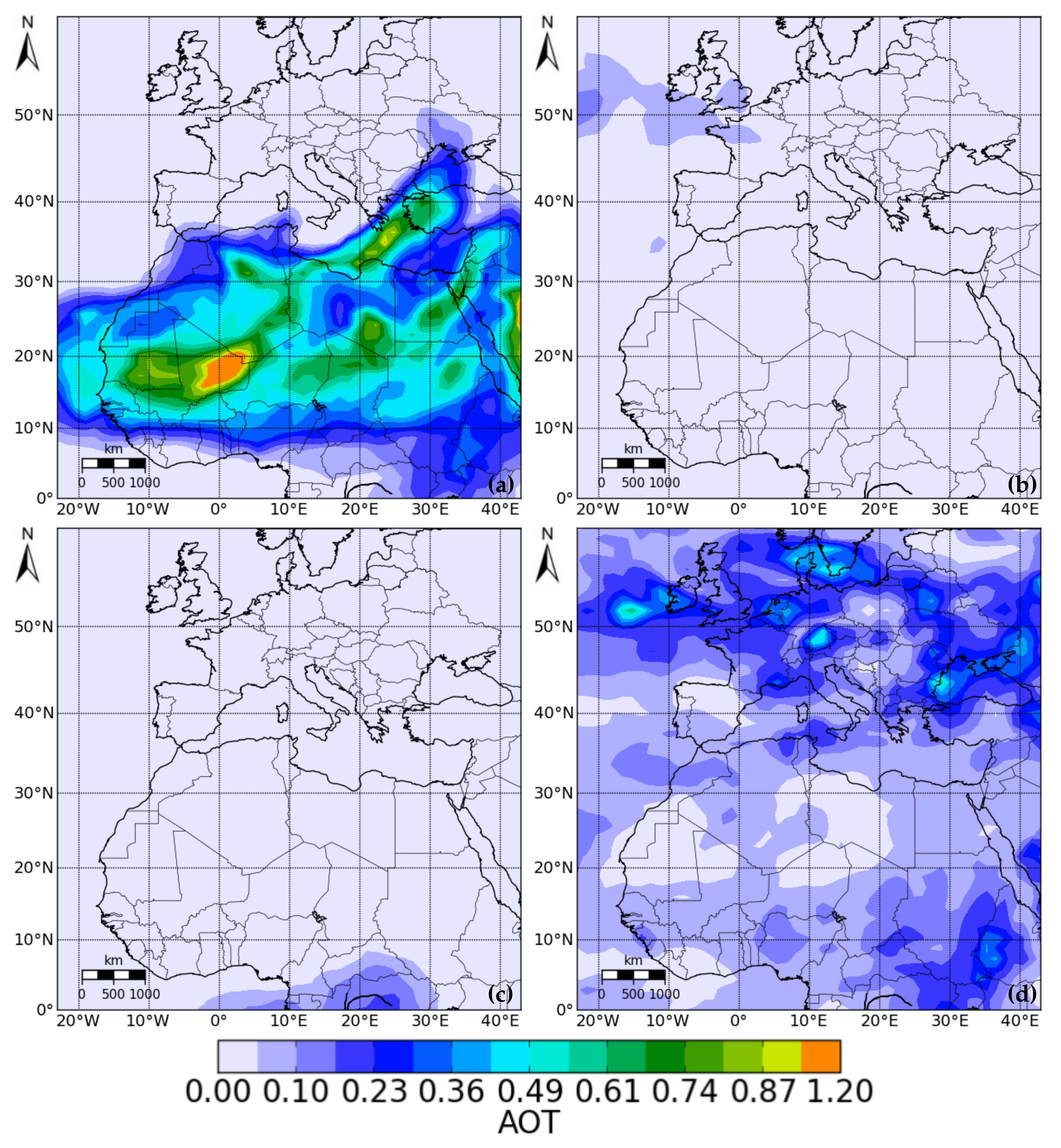

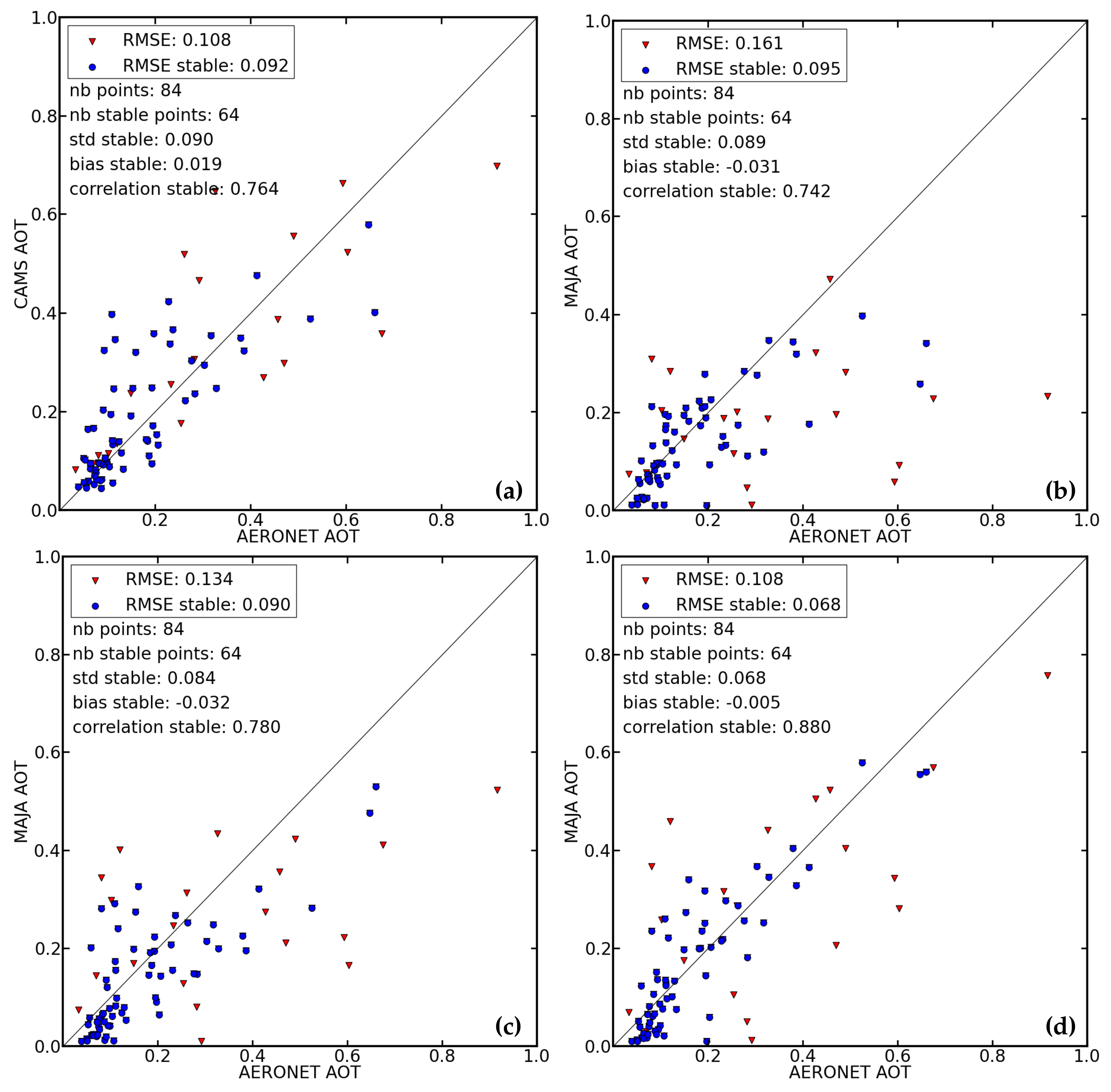
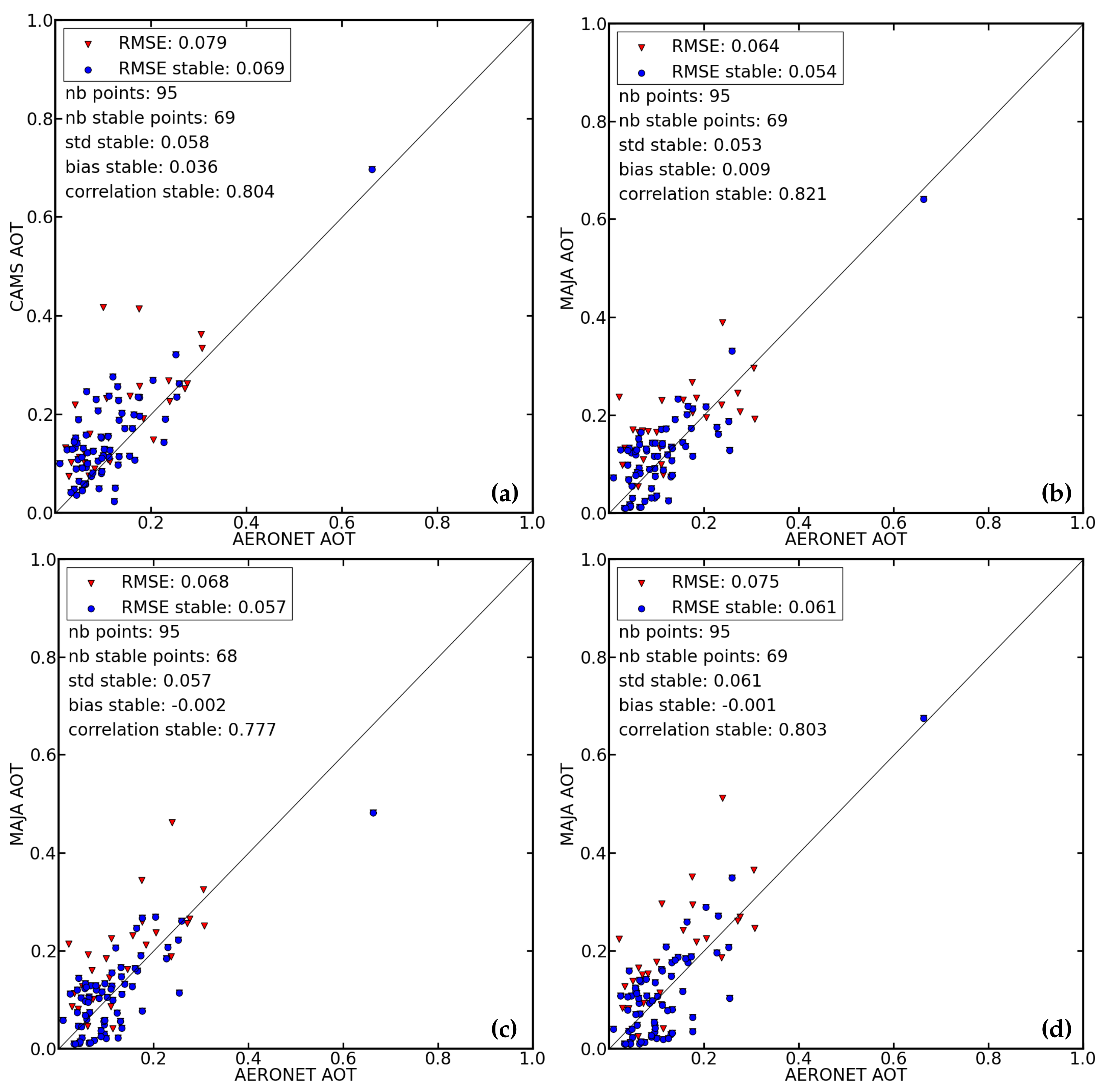

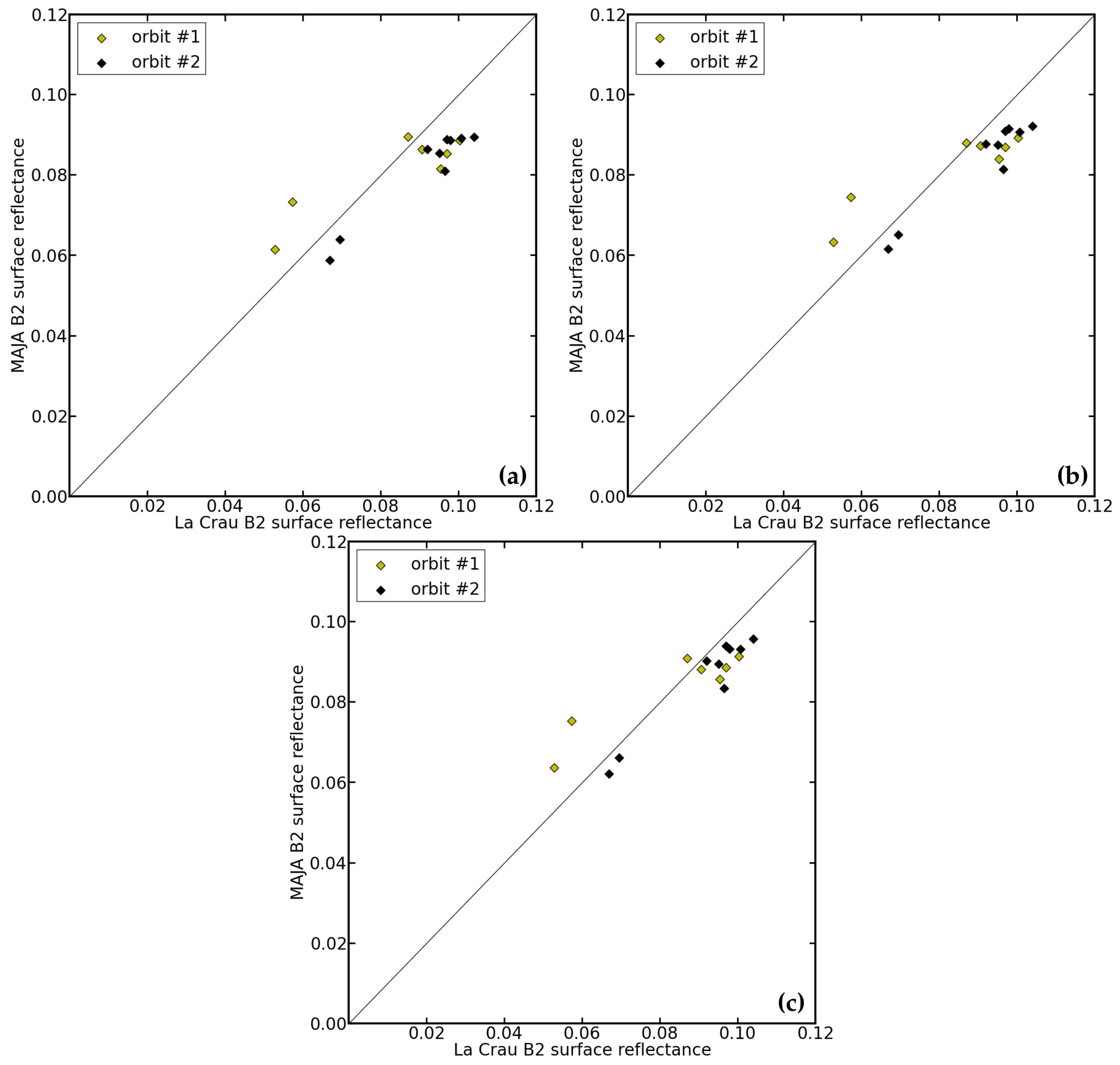

| Band | B1 | B2 | B3 | B4 | B5 | B6 | B7 | B8 | B8a | B9 | B10 | B11 | B12 |
|---|---|---|---|---|---|---|---|---|---|---|---|---|---|
| [nm] | 444 | 496 | 560 | 664 | 704 | 740 | 782 | 832 | 865 | 944 | 1373 | 1613 | 2198 |
| −1.00 | −0.75 | −0.50 | −0.10 | −0.10 | −0.10 | −0.10 | −0.10 | −0.10 | −0.10 | −0.10 | −0.10 | −0.10 |
| Aerosol Type | (m) | (m·g) | Refractive Index | ||
|---|---|---|---|---|---|
| Sea Salt (0.03–0.5 m) | 0.1992 and 1.992 | 1.9 and 2.0 | 6.67 | 1.44− i | 0.999 |
| Sea Salt (0.5–5 m) | 0.50 | 0.986 | |||
| Sea Salt (5–20 m) | 0.15 | 0.982 | |||
| Dust (0.03–0.55 m) | 0.29 | 2.0 | 2.63 | 1.48− i | 0.990 |
| Dust (0.55–0.9 m) | 0.87 | 0.967 | |||
| Dust (0.9–20 m) | 0.43 | 0.944 | |||
| Organic Matter hydrophilic | 0.0527 | 2.0 | 8.62 | 1.40− i | 1 |
| Organic Matter hydrophobic | 0.0355 | 2.0 | 3.07 | 1.52− i | 1 |
| Black Carbon | 0.0118 | 2.0 | 9.51 | 1.75− i | 0.208 |
| Sulfate | 0.0527 | 2.0 | 11.89 | 1.40− i | 1 |
| Site | Latitude | Longitude | Type | AERONET Sites |
|---|---|---|---|---|
| Ben Salem (Tunisia) | 35.55N | 9.91E | arid | Ben Salem |
| Badajoz (Spain) | 38.88N | 7.01W | arid | Badajoz |
| Banizoumbou (Niger) | 13.54N | 2.66E | arid | Banizoumbou |
| Ouarzazate (Morocco) | 30.93N | 6.91W | arid | Ouarzazate, Saada |
| Sede Boker (Israel) | 30.86N | 34.78E | arid | SEDE BOKER |
| Pretoria (South Africa) | 25.76S | 28.28E | arid | Pretoria CSIR DPSS |
| Mongu (Zambia) | 15.27S | 23.13E | arid | Mongu Inn |
| Carpentras (France) | 44.08N | 5.06E | vegetated | Carpentras |
| Zaragoza (Spain) | 41.63N | 0.88W | vegetated | Zaragoza |
| Sirmione (Italy) | 45.50N | 10.61E | vegetated | Sirmione Museo GC, Modena |
| Montsec (Spain) | 42.05N | 0.73E | vegetated | Montsec, Barcelona |
| Toulouse (France) | 43.57N | 1.37E | vegetated | Toulouse MF |
| Kishinev (Moldova) | 47.00N | 28.82E | vegetated | Moldova |
| Alta Floresta (Brazil) | 9.87S | 56.10W | vegetated | Alta Floresta |
| Marbel (Philippines) | 6.50N | 124.84E | vegetated | ND Marbel Univ |
| Arid Sites | ||||||||
|---|---|---|---|---|---|---|---|---|
| Ben Salem | Badajoz | Banizoumbou | Ouarzazate | Saada | Sede Boker | Pretoria | Mongu | |
| constant aerosol type | 0.112 | 0.048 | 0.464 | 0.136 | 0.206 | 0.073 | 0.032 | 0.049 |
| four CAMS aerosol types | 0.083 | 0.051 | 0.342 | 0.101 | 0.103 | 0.135 | 0.041 | 0.128 |
| five CAMS aerosol types | 0.090 | 0.050 | 0.256 | 0.077 | 0.068 | 0.127 | 0.050 | 0.040 |
| Vegetated Sites | |||||||||
|---|---|---|---|---|---|---|---|---|---|
| Carpentras | Zaragoza | Modena | Montsec | Barcelona | Toulouse | Kishinev | Alta Floresta | Marbel | |
| constant aerosol type | 0.056 | 0.056 | 0.026 | 0.072 | 0.053 | 0.034 | 0.039 | 0.052 | 0.046 |
| four CAMS aerosol types | 0.043 | 0.062 | 0.039 | 0.078 | 0.055 | 0.026 | 0.079 | 0.066 | 0.036 |
| five CAMS aerosol types | 0.052 | 0.071 | 0.045 | 0.088 | 0.063 | 0.020 | 0.042 | 0.072 | 0.038 |
| Arid Sites | |||
|---|---|---|---|
| Black Carbon Refractive Index | RMSE | Standard Deviation | Bias |
| 1.75−0.45 i | 0.076 | 0.071 | −0.027 |
| 1.75−0.20 i | 0.072 | 0.068 | −0.022 |
| Vegetated Sites | |||
| Black Carbon Refractive Index | RMSE | Standard Deviation | Bias |
| 1.75−0.45 i | 0.079 | 0.079 | 0.008 |
| 1.75−0.20 i | 0.065 | 0.065 | 0.003 |
| Dust Refractive Indices from CAMS | |||
| (e.g., 1.48−0.0016 i at 550 nm) | |||
| RMSE | Standard Deviation | Bias | |
| four CAMS aerosol types | 0.105 | 0.098 | −0.039 |
| five CAMS aerosol types | 0.106 | 0.099 | −0.038 |
| Dust Refractive Indices from [46] | |||
| (e.g., 1.53−0.0052 i at 550 nm) | |||
| RMSE | Standard Deviation | Bias | |
| four CAMS aerosol types | 0.081 | 0.078 | −0.019 |
| five CAMS aerosol types | 0.072 | 0.068 | −0.023 |
| B2 (496 nm) | B3 (560 nm) | B4 (664 nm) | B8 (832 nm) | B11 (1613 nm) | |
|---|---|---|---|---|---|
| constant aerosol type | −5.7 | −6.6 | −6.3 | −7.2 | −4.7 |
| four CAMS aerosol types | −3.9 | −4.6 | −4.6 | −6.4 | −4.4 |
| five CAMS aerosol types | −1.9 | −3.1 | −3.5 | −5.6 | −4.1 |
| Mean Value (24 Days) | Standard Deviation | |
|---|---|---|
| B2 (496 nm) | 1.01 | 0.04 |
| B3 (560 nm) | 0.99 | 0.03 |
| B4 (664 nm) | 0.99 | 0.04 |
| B8 (832 nm) | 0.94 | 0.03 |
| B11 (1613 nm) | 0.98 | 0.03 |
| B2 (496 nm) | B3 (560 nm) | B4 (664 nm) | B8 (832 nm) | B11 (1613 nm) | B12 (2198 nm) | |
|---|---|---|---|---|---|---|
| Constant aerosol | 0.005 | 0.007 | 0.011 | 0.015 | 0.018 | 0.015 |
| Four CAMS aerosol types | 0.005 | 0.007 | 0.011 | 0.014 | 0.018 | 0.015 |
| Five CAMS aerosol types | 0.005 | 0.007 | 0.011 | 0.015 | 0.018 | 0.015 |
| B2 (496 nm) | B3 (560 nm) | B4 (664 nm) | B8 (832 nm) | B11 (1613 nm) | B12 (2198 nm) | |
|---|---|---|---|---|---|---|
| Constant aerosol | 0.006 | 0.007 | 0.010 | 0.022 | 0.019 | 0.015 |
| Four CAMS aerosol types | 0.006 | 0.007 | 0.010 | 0.022 | 0.019 | 0.015 |
| Five CAMS aerosol types | 0.006 | 0.007 | 0.010 | 0.022 | 0.019 | 0.015 |
| B2 (496 nm) | B3 (560 nm) | B4 (664 nm) | B8 (832 nm) | B11 (1613 nm) | B12 (2198 nm) | |
|---|---|---|---|---|---|---|
| constant aerosol | 0.100 | 0.146 | 0.206 | 0.294 | 0.377 | 0.291 |
| Four CAMS aerosol types | 0.101 | 0.149 | 0.209 | 0.297 | 0.379 | 0.293 |
| Five CAMS aerosol types | 0.103 | 0.152 | 0.213 | 0.302 | 0.382 | 0.294 |
| B2 (496 nm) | B3 (560 nm) | B4 (664 nm) | B8 (832 nm) | B11 (1613 nm) | B12 (2198 nm) | |
|---|---|---|---|---|---|---|
| constant aerosol | 0.052 | 0.079 | 0.085 | 0.295 | 0.236 | 0.143 |
| Four CAMS aerosol types | 0.054 | 0.083 | 0.089 | 0.298 | 0.237 | 0.144 |
| Five CAMS aerosol types | 0.055 | 0.084 | 0.090 | 0.301 | 0.238 | 0.145 |
© 2017 by the authors. Licensee MDPI, Basel, Switzerland. This article is an open access article distributed under the terms and conditions of the Creative Commons Attribution (CC BY) license (http://creativecommons.org/licenses/by/4.0/).
Share and Cite
Rouquié, B.; Hagolle, O.; Bréon, F.-M.; Boucher, O.; Desjardins, C.; Rémy, S. Using Copernicus Atmosphere Monitoring Service Products to Constrain the Aerosol Type in the Atmospheric Correction Processor MAJA. Remote Sens. 2017, 9, 1230. https://doi.org/10.3390/rs9121230
Rouquié B, Hagolle O, Bréon F-M, Boucher O, Desjardins C, Rémy S. Using Copernicus Atmosphere Monitoring Service Products to Constrain the Aerosol Type in the Atmospheric Correction Processor MAJA. Remote Sensing. 2017; 9(12):1230. https://doi.org/10.3390/rs9121230
Chicago/Turabian StyleRouquié, Bastien, Olivier Hagolle, François-Marie Bréon, Olivier Boucher, Camille Desjardins, and Samuel Rémy. 2017. "Using Copernicus Atmosphere Monitoring Service Products to Constrain the Aerosol Type in the Atmospheric Correction Processor MAJA" Remote Sensing 9, no. 12: 1230. https://doi.org/10.3390/rs9121230




